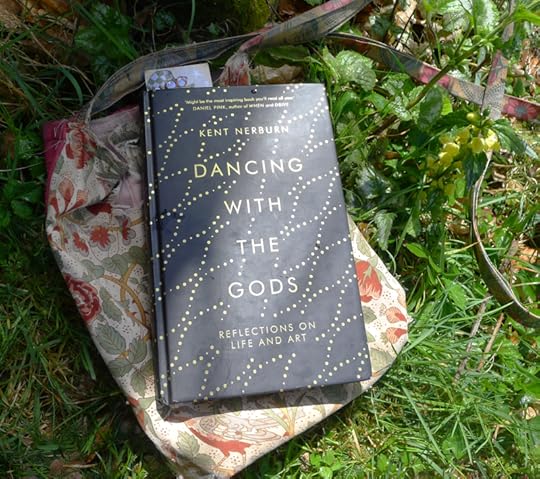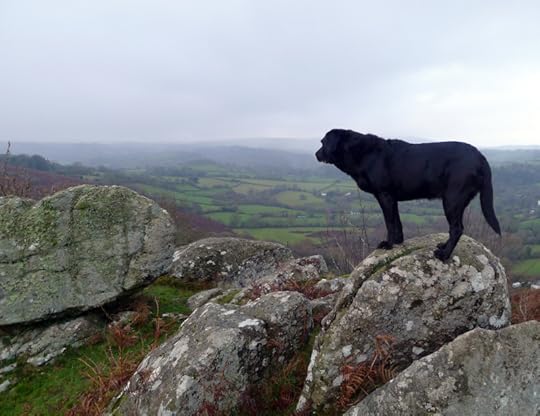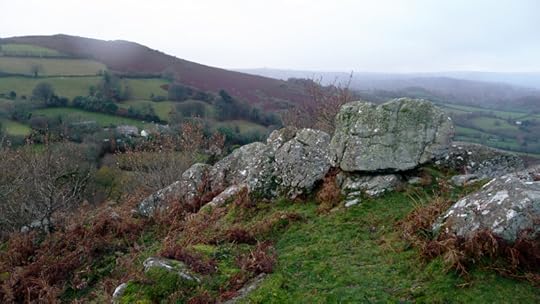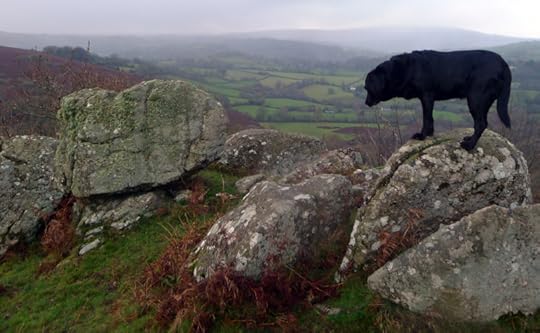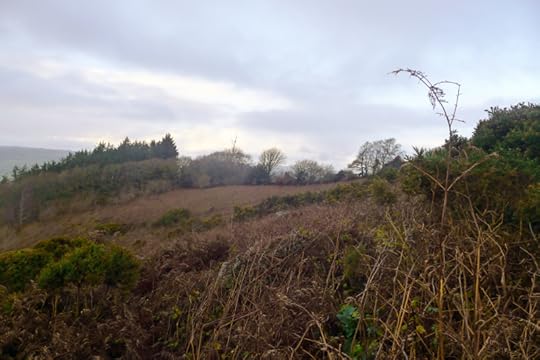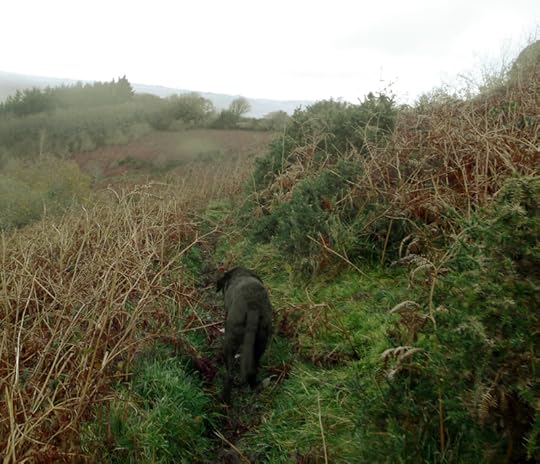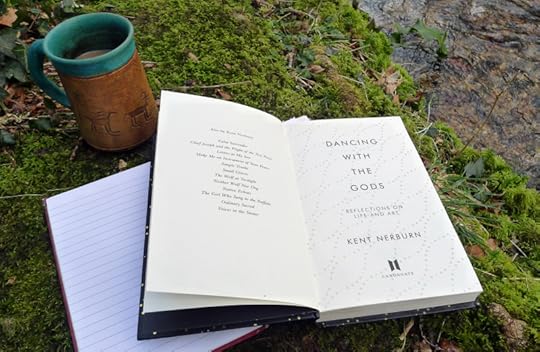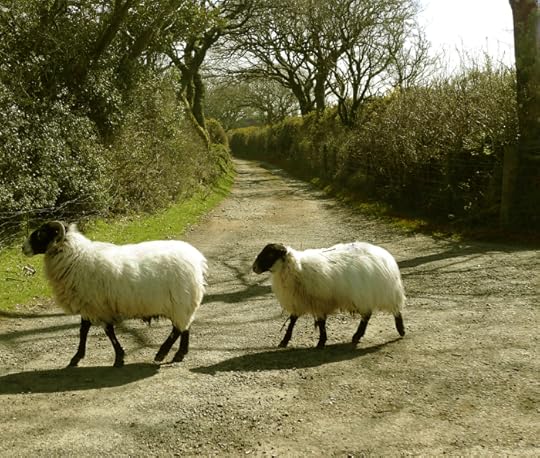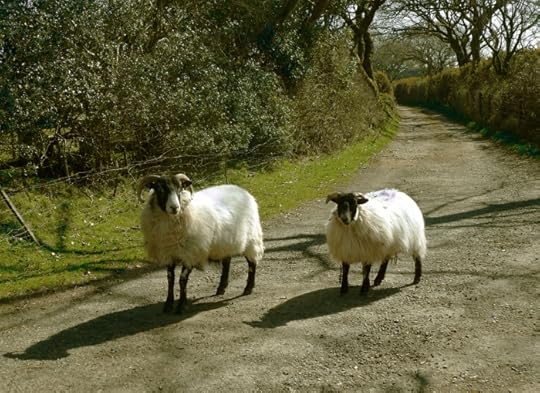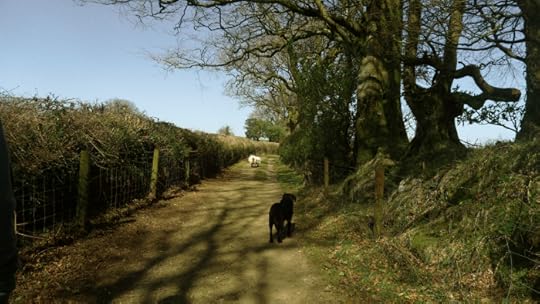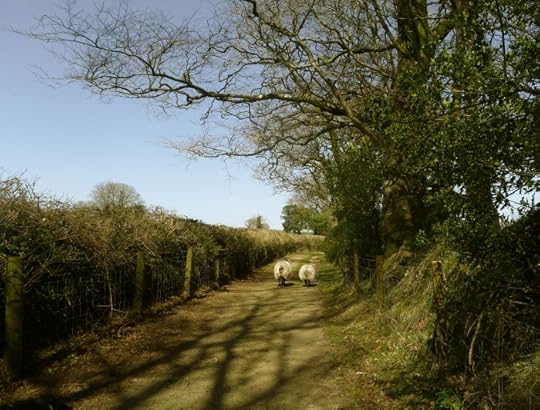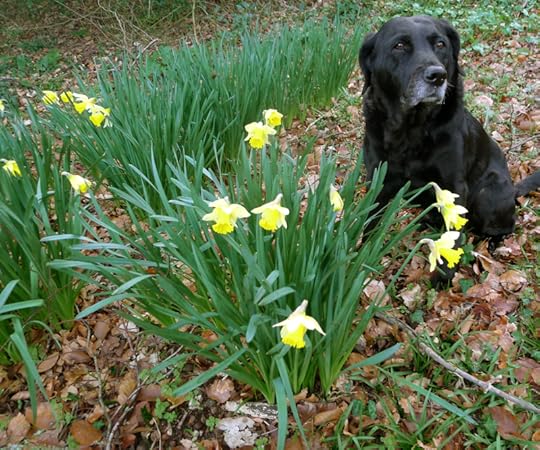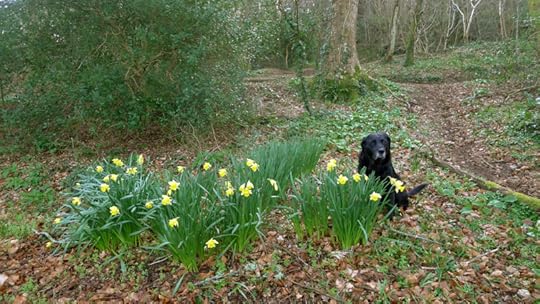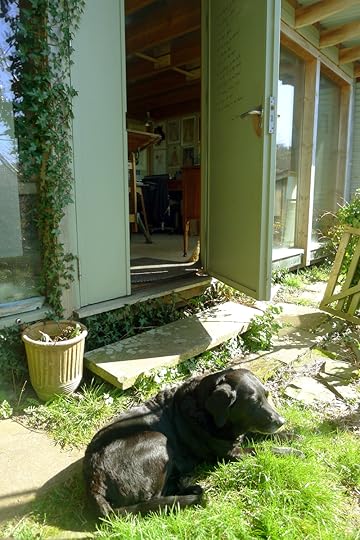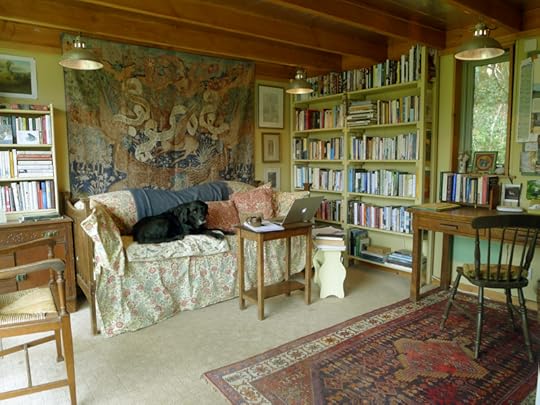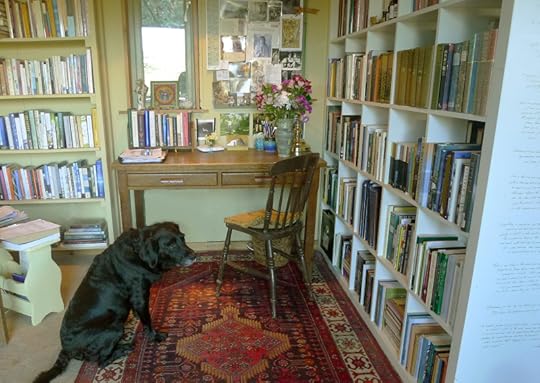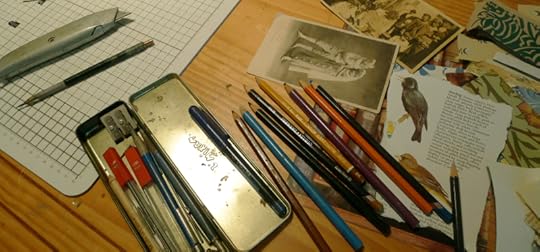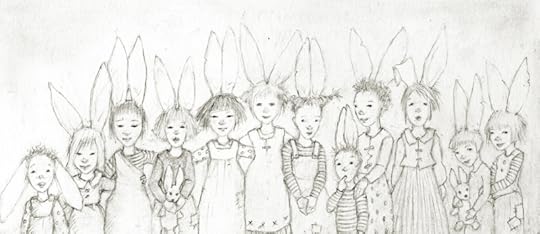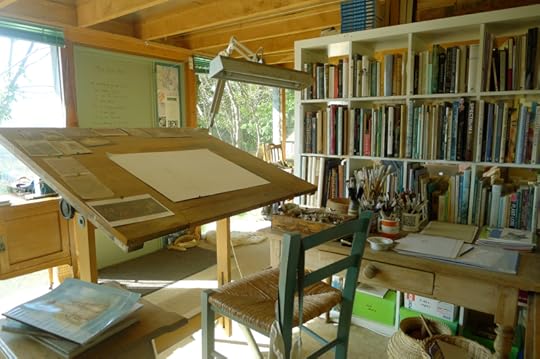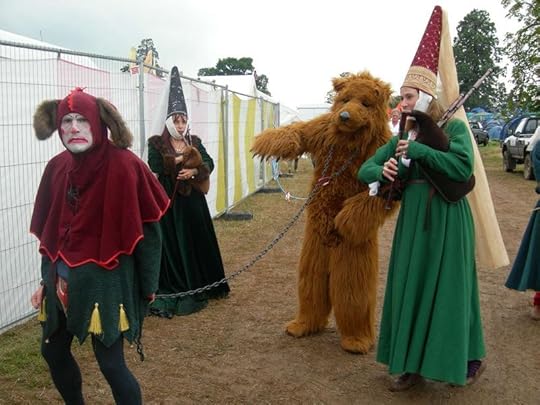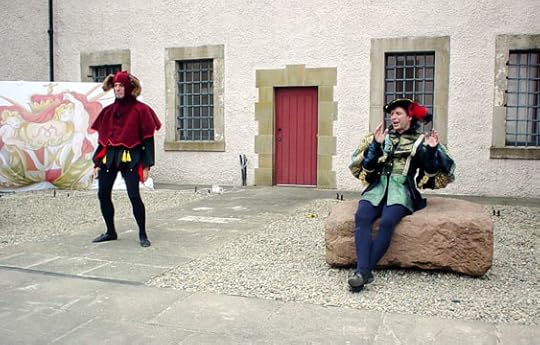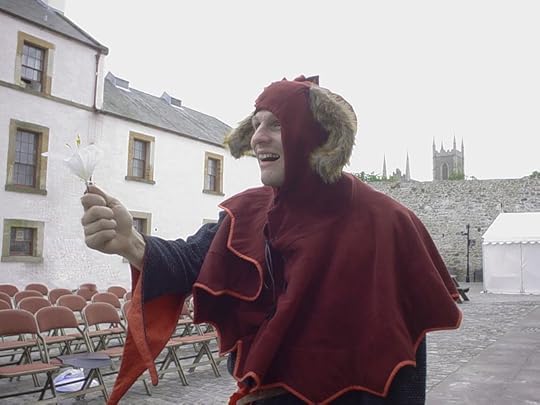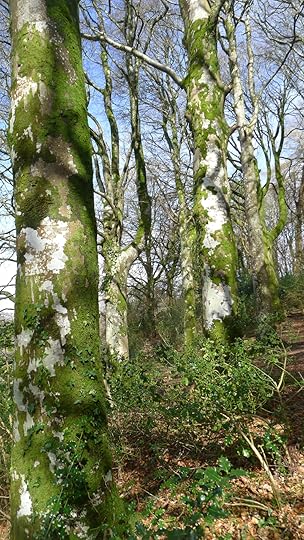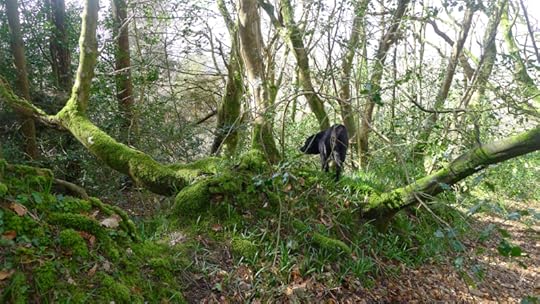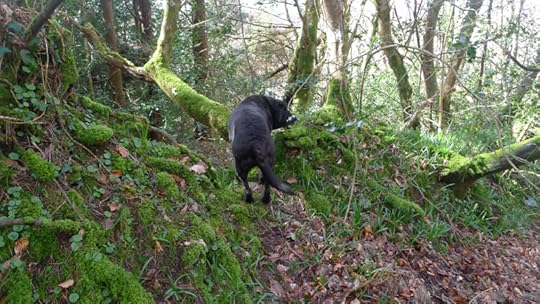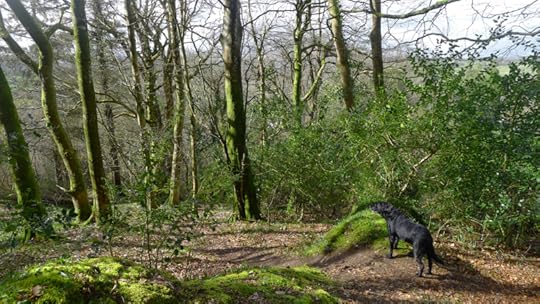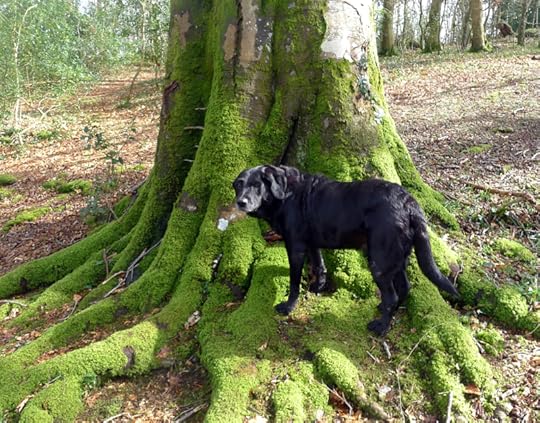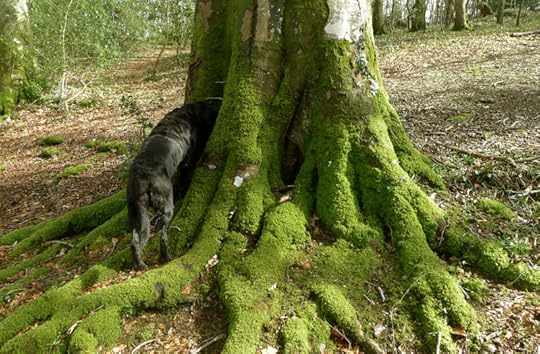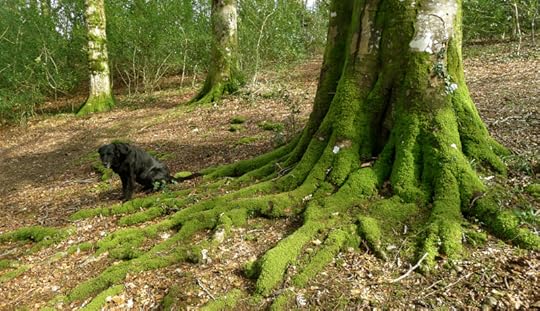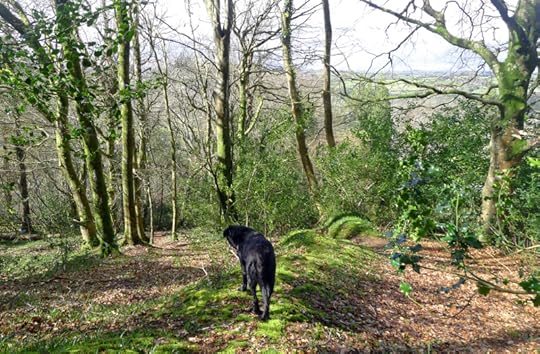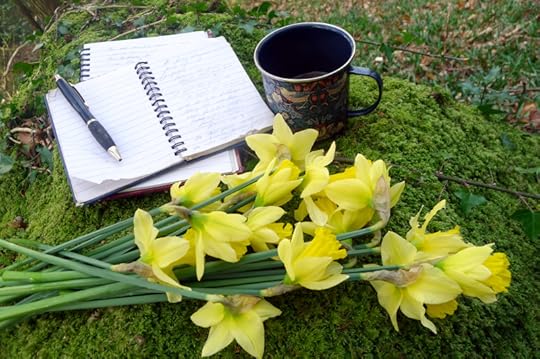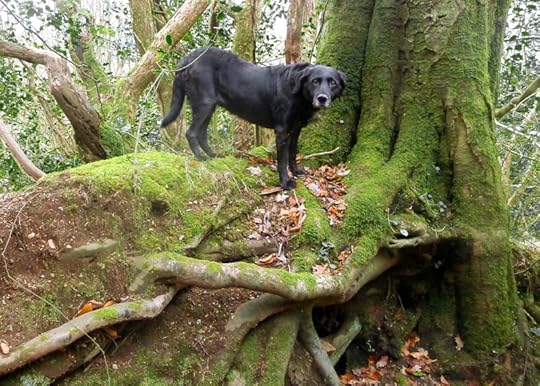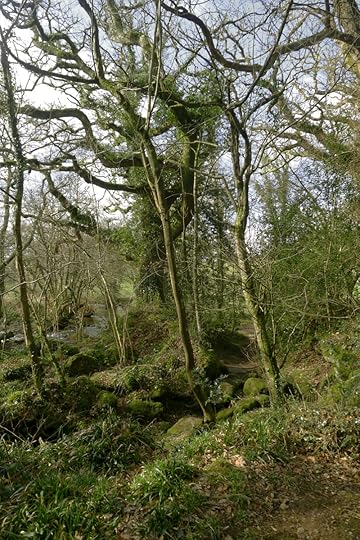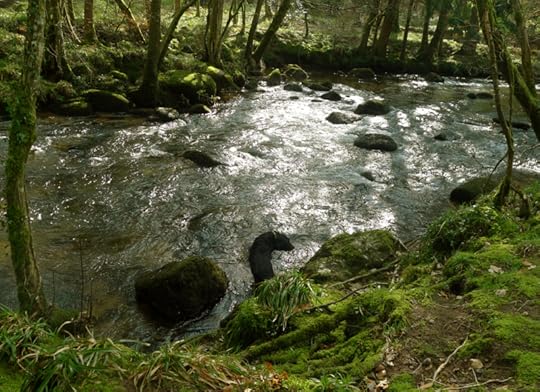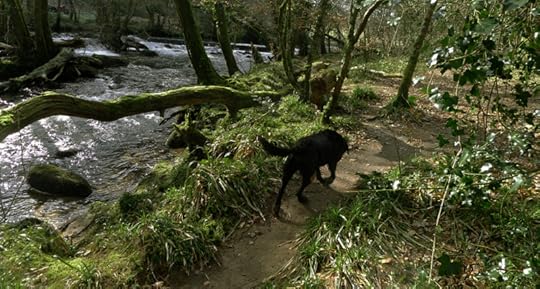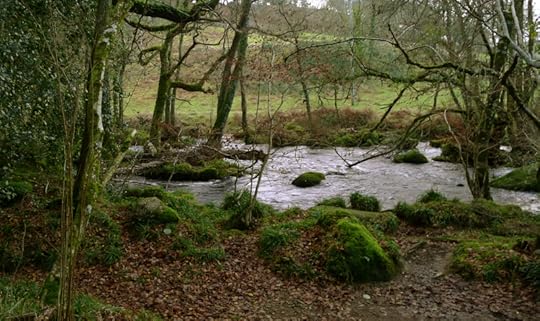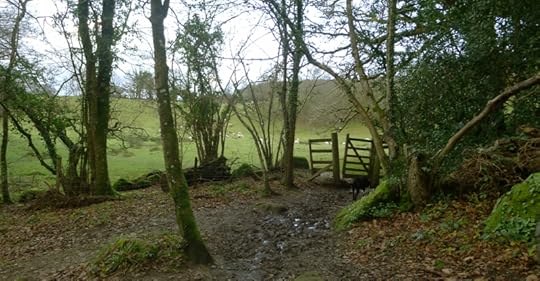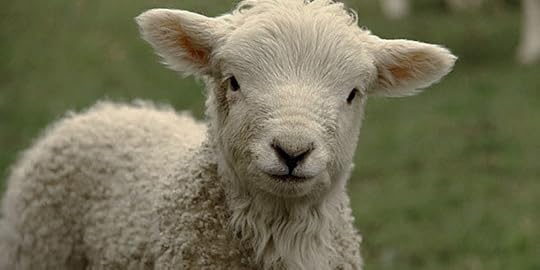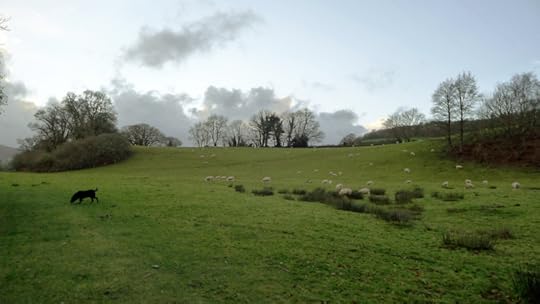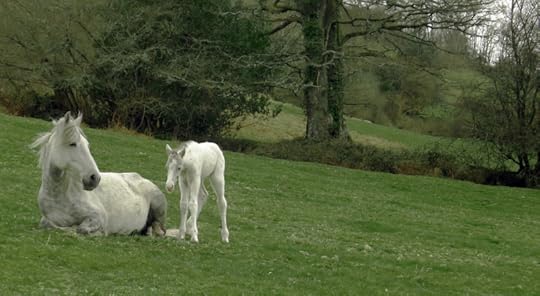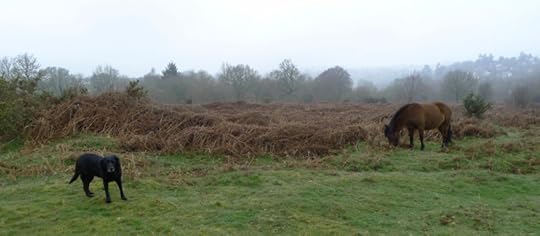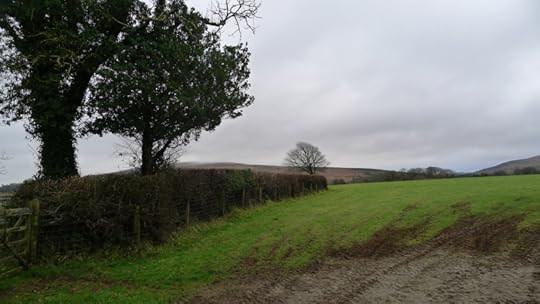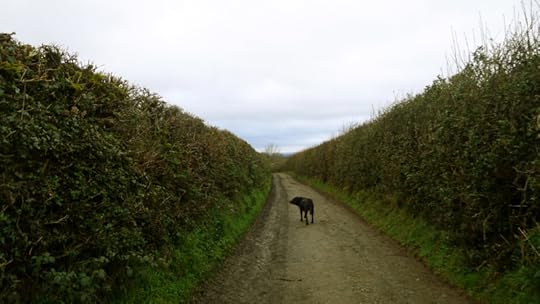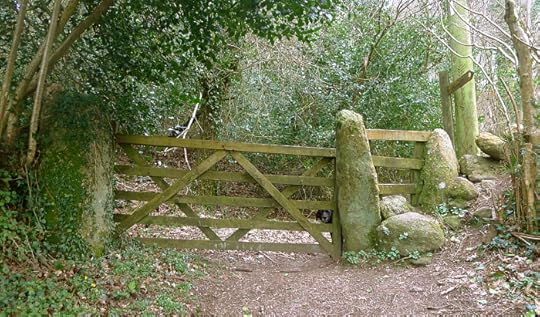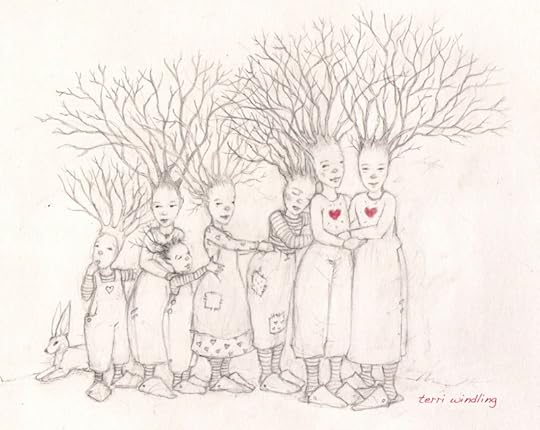Terri Windling's Blog, page 19
April 6, 2021
On losing the way
I always carry a book with me on my rambles through the hills with Tilly: not the same books that I read at home (nonfiction in the morning, fiction at night), but something I can read in daily increments on coffee breaks outdoors ... poetry perhaps, or volumes on art-making, or myth, or the natural world. The book in my tattered "walking bag" this week is Kent Nerburn's Dancing With the Gods: Reflections on Life and Art. I can't remember who recommended it; but whoever it was, I'm grateful. It's giving me a lot to think about.
The passage below, for example, discusses that part of the creative process when artists get stuck or lose their way -- which is precisely where I'm at with a certain section of The Moon Wife, my novel-in-progress. I know what ought to happen next, but a vital scene is refusing to unfold, threatening to carry me off in a new direction from the one I'd planned. Matching stubbornness to stubbornness, neither me nor the scene is giving way; and I know very well what I should do now, but I needed these words to remind me:
"No matter what your art form, there is a moment in almost every project when you feel that your work has got away from you. The character you are developing seems false. The story you are writing seems flat and uninteresting. All the choices you have made seem wrong-headed or misdirected and you can see no clear path forward. You are lost in a creative wilderness and you don't know how to escape.
"All of us have known these moments. They are part of the creative process. But that does not make them easier to endure. To feel a vision turn to dust in your hands is a painful experience, and he doubt that sets in is not subject to rational analysis. Is this the moment, you wonder, when my vision has left me? Is this the time when I took on too much, when I went at things from a wrong direction, when I overreached my own capabilities?"
There is no need for panic, writes Nerburn:
"As the French poet Anna de Noailles said, 'It's at midnight that one has to believe in the sun.' But even more, it is when you are in darkness that the moments of magic can happen because these are the moments when you are freed from the shackles of expectations and set free in the fields of creative recovery....
"I have had characters get away from me in writing, sending my plot in directions that made me despair of all my plans and expectations, only to find in the end that the characters, having wrested the story from me, moved it in directions that were at once richer and more complex than I had ever imagined. Every artist who has been working long enough to have had successes and failures can tell similar stories. It is the nature of creation for works to grow and take on lives of their own, often defying the artist's most cherished intentions.
"When this happens, you need to have confidence you are not lost; you are just on the point of new discovery. Your work has climbed out of the shape of your original idea and begun to claim a life of its own. Einstein put it well when he said, 'No worthy problem is ever solved within the plane of its original conception.' "
My husband Howard, working in theatre, often uses the term "the Dark Forest" to refer the time in the art-making process when the creation of a play (or story, or painting) reaches a crisis point: when the path disappears, the idea loses steam, the plot line tangles, that palette muddies, and you can see no way to move forward. This often occurs, just as Nerburn says, right before true magic happens: first there's the crisis, then a breakthrough, an unexpected solution, and the piece comes fully to life.
Howard kept a journal one year while directing a fairy tale play in Porto, Portugal; and somewhere around the middle of the project he wrote this:
"Today I arrived in the middle of the Dark Forest, and the path has almost disappeared. It is scary now, and all the certainties have gone. The cast members are weary, and their ability to come up with interesting work has diminished. Even our opening meditation today felt tired. The Dark Forest. I knew I was heading into it, and, as always, the Forest has its own way of manifesting in each creative project. Perhaps the actors are getting stuck, unable to develop their parts. Perhaps our storytelling has become a little flat, or maybe I'm forgetting important, simple things, like the clear development of the hero's character throughout the play....
"It's difficult to keep my original vision of the piece as I travel through the Dark Forest. I have to trust the vision I had at the start of the work, and that the ideas that have been set in motion will somehow come together. I know that I can't lose faith now, even though at this point in the creative process one often starts to question the show, the cast, and one's own ability.
"I can't turn around. I have to keep going, through this tough period, and find energy from somewhere! I'm reminded of the first day of the pilgrimage I took seven years ago, across the mountains of France and Spain to Santiago de Compostela. I cycled up route Napoleon late in the day, as the sun was setting, knowing that no matter how exhausted I was I had to push on to Roncesvalles. I could not turn back as I was too far along the path -- but if I did not get to the monastery before sundown, I would surely lose my way in the dark and cold; I could die of exposure lost in the Pyrenees. This is the feeling I have now: I'm exhausted, I don't know when the turning point will come, but I have to plough on."
I'm definitely lost in the Dark Forest of my novel. It's an uncomfortable place to be, but I'm not panicking. I know these woods. And after all these years of working with words, I do know what I need to do: Follow the story. Trust the story.
Head into the dark unknown and just plough on.
The passage above is from Dancing With the Gods by Kent Nerburn (Canongate, 2018); all rights reserved by the author. The poem in the picture captions is from Sands of the Well by Denise Levertov (New Directions, 1996); all rights reserved by the Levetov estate. The fairy tale drawings are by John D. Batten (1860-1932) and H.J. Ford (1860-1941).
April 5, 2021
Tunes for a Monday Morning
Above: "Steppy Downs Road" by English fiddle player and multi-instrumentalist Sam Sweeney, recorded live at Cecil Sharp House in London last year -- accompanied by Jack Rutter and Louis Campbell on guitars, and Ben Nicholls on double bass. Sweeney performs with Bellowhead, Leveret, The Full English, Jon Boden's The Remnant Kings, Fay Hield's The Hurricane Party and other bands in addition to his solo work. This song appears on his second solo album, Unearth Repeat, which I highly recommend.
Below: "The Old Wagon Way" from Unearth Repeat.
Above: "Notland Castle" by the Scots/English folk trio Lau (Kris Drever, Martin Green, and Aidan O'Rourke). The song can be found on their lovely live album Unplugged (2020).
Below: "Riad," also from Unplugged.
Above: "Seven Bonnie Gypsies" performed by Jon Boden & The Remnant Kings, with animation by Marry Waterson. The song is a variant of "Raggle Taggle Gypsies" (sung here by Boden's partner Fay Hield). It appeared on Boden's fine album Rose in June (2019).
Below: "Bee Sting" from Afterglow (2017), performed for the Hudson Sessions in Sheffield that same year. Boden's most recent album is Last Mile Home (2021), and it's simply gorgeous.
Photographs: An Easter walk in a Belstone lane. With sheep.
April 4, 2021
Easter on Dartmoor
 As the morning fills with the magical sound of church bells drifting over the village, Tilly and I send these wild daffodils out to all who have celebrated Easter today, or Passover recently, or any other seasonal festival marking the the moon's cycles and the change of the season.
As the morning fills with the magical sound of church bells drifting over the village, Tilly and I send these wild daffodils out to all who have celebrated Easter today, or Passover recently, or any other seasonal festival marking the the moon's cycles and the change of the season.
''People from a planet without flowers would think we must be mad with joy the whole time to have such things about us,'' Iris Murdoch once said. The spring wildflower season has begun here in Devon and it does indeed fill me with joy.
Sadly, the sunrise Easter service usually held outdoors at the top of out hill is not taking place again this year due to Covid-19 restrictions. Here's a post about it from a previous year, titled "Morning has broken."
The little Tree Child sketch above is one of mine.
April 3, 2021
Once upon a time...
���Stories are like invisible seeds," says Native American writer and scholar Greg Sarris.| They live in the very air we breathe. They are around us at all times." -
Indeed they do. And in this bright spring weather, I can almost see them spinning around me, everywhere I look.
April 2, 2021
On judgement and excellence
From Dancing With the Gods: Reflections on Life and Art by Kent Nerburn:
"Our feelings about any work we create wax and wane. Some days we are filled with enthusiasm for it; other days it seems dull and lifeless. Some nights I will go to bed excited about what I left unfinished only to wake in the morning and find it insipid and incoherent. In the same fashion, I will discard a work as turgid and fragmentary, only to go back to it several months later and find beauty in it that leaves me wondering what it was that had caused me to discard it in the first place.
"We are often the worst judges of our own work. Either we see its deficiencies in high relief or we overestimate its capacity to express what we set out to reveal. We are too close to it and too invested in it to see its strengths and weaknesses.
"How are we to know if what we have done is good? The hard truth is that we can't. If you are the type of artist who values audience response or external success, perhaps those are viable measures. But if you are like most of us, you are harder on yourself than anyone else is. And you have not arrived at where you are by minimising your weaknesses. So you see your work poorly, if at all.
"What I would like to suggest is that if there is no reliable measure of quality, the is one internal reliable measure that you can still use as a guide. It is excellence.
"Excellence is a habit -- it is a mode of creating. It is fluid and it is malleable in its expression, but it is consistent in its intention. If you establish the habit of excellence in your work, it will always be there, no matter how distant you feel from that work or how flawed it felt in the act of creation.
"Excellence cannot be quantified and it is different for each person. It is where your character shines through your creation. It is your commitment, frozen in time and space. It is your spiritual signature on your work."
As you progress through your life, Nerburn goes on to say,
"you will discover that the works you create leave tracks. Though you do not work for a legacy, you create one. Your work becomes a history of your time on earth. It is like a string of pearls, formed of the works you have created or the performances you have given; a family of your artistic children. Not all came forth equal in form and grace. Some came into being more easily; some took on a life of their own more swiftly and with more certainty. But in the end they are all your legacy and your history, and your reason for having been here.
"It is easy to become focused on the more external aspects of our artistic efforts -- Will people like my work? Will it advance my career? -- or to get caught up in fruitless attempts to decide if our work has any inherent merit. But if you keep your eye always on the challenge of making every work excellent within the constraints that are placed on you, whether by deadlines, the shape of the project or your own capacity to achieve the ends you envision, you are setting and internal standard that is impervious to outside influence.
"When you reach the point in life's journey where you turn back and look on what you have done, what will matter is the way your spirit shone through the works you have created. You may blush at the naivety of some of them and you may be astonished at the sophistication of others. You may say, 'I wish I could do that one over,' or you may say, 'How did I do that? I could never do that again.' But what is important is that you are able to say that each one reflected the greatest excellence of which you were capable of at the time.
"Time changes our perspective. We find our aesthetics, our interests, and our skills have moved far from where we began. But excellence, since it is the highest expression of our creative capability, becomes our unique artistic signature. It shines through all our artistic endeavors and forms a luminous thread that unites them."
The passage above is from Dancing With the Gods by Kent Nerburn (Canongate, 2018); all rights reserved by the author. A related post: On fear of judgement (and pernicious perfectionism).
April 1, 2021
Dare to be Foolish
In honour of April Fool's Day, here is an often-requested post from the Myth & Moor archives....
I've been thinking about another aspect of "finding ones voice" as a creative artist: developing the courage to let that voice be heard -- despite the personal nature of art, and the things that our art reveals about us.
For women in particular, schooled for centuries to be the "invisible helpmeet" (what Virginia Woolf called "the angel in the house"), daring to speak and be heard can be a fearful prospect even while we professionally seek it out; but some men, too, suffer silently from the writer's/painter's version of stage-fright: the fear of putting our work, our soul, out there, having it judged, and appearing foolish. So we then hold back, or tone the work down . . . or worse, we don't create at all.
The simple truth is that being a creative artist takes courage; it's not a job for the faint of heart. It takes courage each and every time you put a book or poem or painting before the public, because it is, in fact, enormously revealing. (Delia Sherman once likened the publishing of a novel to walking down the street buck naked.) Worse yet, what our work often reveals is not the beautifully-lit, carefully-presented surface of our creativity, but the darker shadow-play at its interior. That can't be helped. But the good news is: that's precisely where the best art comes from.
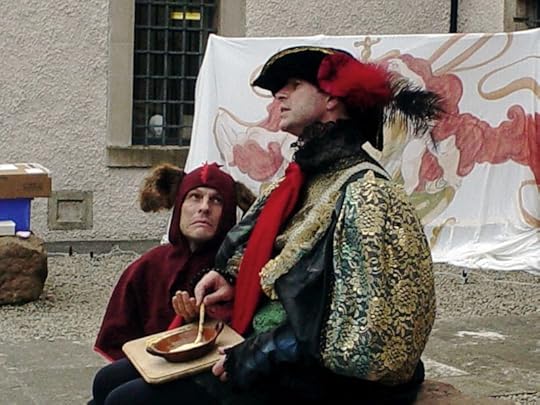
While our intellect chases its bright and lofty visions, our most original, powerful ideas tend to rise from muddy, murky depths below: from the clouded waters of the subconscious; from the baffling landscape of nightmare and dream; from the odd obssessions, weird fixations, and uncanny flashes of intuition that rise up from those strange parts of ourselves that we know and approve of least; from those places most likely to make us feel ridiculous, and exposed.
The muse, if we follow her far enough, and honestly enough, demands that we bare it all: our angel wings and our asses' ears. It doesn't matter if we're writing genre fiction and not memoir; it doesn't matter if we're painting fairy tales and not self-portraits.
"All art is autobiographical," said Federico Fellini; "the pearl is the oyster's autobiography."
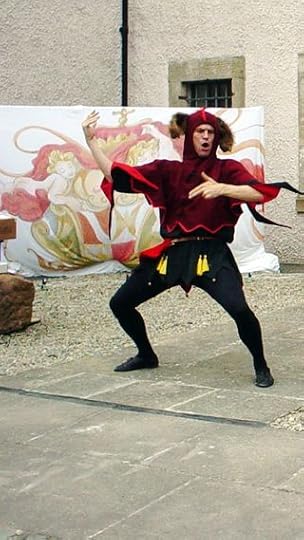 When Ellen Kushner and I were young writers together in New York City in the 1980s (that distant, different pre-Internet age), Cynthia Heimel published an essay called "How to be Creative" that we adopted as a kind of Call to Arms, passing a dog-earred copy around to all our friends for many years thereafter. First published in The Village Voice, the essay contained the exact advice that earnest, anxious, ambitious young writers and artists like us most needed to hear. I haven't been able to find a copy for you to read online, but here's another quote from the author of our Sacred Text (as Ellen and I referred to it) that pretty much sums up the article in question:
When Ellen Kushner and I were young writers together in New York City in the 1980s (that distant, different pre-Internet age), Cynthia Heimel published an essay called "How to be Creative" that we adopted as a kind of Call to Arms, passing a dog-earred copy around to all our friends for many years thereafter. First published in The Village Voice, the essay contained the exact advice that earnest, anxious, ambitious young writers and artists like us most needed to hear. I haven't been able to find a copy for you to read online, but here's another quote from the author of our Sacred Text (as Ellen and I referred to it) that pretty much sums up the article in question:
"When in doubt, make a fool of yourself," says Heimel. "There is a microscopically thin line between being brilliantly creative and acting like the most gigantic idiot on earth. So what the hell, leap."
Three decades later, this is still the best piece of art-making advice I know.
I hereby pass the [paraphrased] words of the Sacred Text on to the next generation of writers- and artists-in-training:
Don't be afraid to be weird, don't be afraid to be different, don't worry too much about what other people think. Whatever it is that's original in you and your work might sometimes make you feel uncomfortable. That probably means you're on the right track, so just keep going.
Dare to be foolish.
Pictured above: My husband Howard Gayton (Fool), William Todd-Jones (Bear), and Geoff Beale (Cavalier) performing with Daughters of Elvin in Devon and Northern Ireland. A related post: On fear of judgement (and pernicious perfectionism).
March 31, 2021
In the quiet of the woods
After months and months of dealing with Long Covid (on top of a long-term health condition), I can't manage long walks with Tilly yet, so we usually head to the woods close by -- where I sit while Tilly prowls through the underbrush, never straying far. Sometimes I read, sometimes I write, and sometimes I do nothing at all, absorbing the quiet while beech, holly, oak and ash all absorb me in turn.
Once she's explored the terrain, Tilly sits close: ears cocked, nose twitching with every scent. I watch her and wish I could see as she sees, hear as she hears, live as fully in this bright moment in time -- remembering that I am an animal too, made of water and wind and the dust of stars.
The life of a freelance writer and editor is measured in hours of productivity, and it takes some effort to slough off guilt when time spent silent among the trees results in no tangible accomplishment: no pages written or manuscript read or email answered or paycheck earned. And yet I'm convinced that it's on such moments that every other part of my creative life rests.
The land is muse, teacher, and mentor. It is doctor, pastor, and therapist. It is the place where I return to myself when the jangle of life, the demands of work, and the ceaseless clamour of the Internet lead me astray. In the quiet of the greenwood it all fades away. I can hear my own softer voice once again.
But now I am justifying time spent outdoors by emphasizing the manner in which it supports my productivity back in the studio -- and while this is true, it is not the only truth. Quiet moments are worth much more than this. I will not measure their value in output, in books and paintings made and sold. I will not hang a price tag on my love for the natural world. I am not a consumer of the forest, obtaining my money's worth from the trees and grasses, the fungi and moss. I am just a woman sitting in the green arms of the Mother who made me. Just sitting. Just healing. Just being, for these precious moments, alive and present.
I am not dismissing the importance of productivity for those of us working in the arts, or of enagagement with the media and marketplace which places our work in the hands of others, for I believe that art is important, even sacred, and is capable of no less than changing the world.
But then, so is this: these quiet hours in the dappled light of the greenwood, with my good dog beside me. It changes my world. It changes me. And that's all the value it needs.
"I pin my hopes," said the Quaker writer Rufus Jones, "to quiet processes and small circles, in which vital and transforming events take place."
I pin my own hopes to the rustle of leaves, the murmur of water, the grace note of the birdsong overhead; to the ordinary, daily domestic act of rising in the morning and walking the dog. And to art, of course, but also to this. To the quiet of the woods.
The quote by Quaker historian and philosopher Rufus Jones is from a letter to Violet Holdsworth, 1937. The poem in the picture captions is from Swan: Poems and Prose Poems by Mary Oliver (Beacon Press, 2012). All rights reserved by the authors' estates.
March 30, 2021
A blessing for a Tuesday afternoon
A Blessing
by Denise Levertov (1923-1997)
'Your river is in full flood,' she said,
'Work on - use these weeks well!'
She was leaving, with a springy step, a woman
herself renewed, her life risen
up from the root of despair she'd
bent low to touch,
risen empowered. Her work now
could embrace more: she imagined anew
the man's totem tree and its taproot,
the woman's chosen lichen, patiently
composting rock, another's
needful swamp, the tribal migrations -
swaying skeins rotating their leaders,
pace unflagging, and the need
of each threatened thing
to be. She had met
with the council
of all beings.
'You give me my life,'
she said to the just-written poems,
long-legged foals surprised to be standing.
The poet waving farewell
is not so sure of the river.
Is it indeed
strong-flowing, generous? Was there largesse
for alluvial, black, seed-hungry fields?
Or had a flash-flood
swept down these tokens
to be plucked ashore, rescued
only to watch the waters recede
from stones of an arid valley?
But the traveler's words
are leaven. They work in the poet.
The river swiftly
goes on braiding its heavy tresses,
brown and flashing
as far as the eye can see.
The poem above is from The Collected Poems of Denise Levertov (New Directions, 2013). The poem in the picture captions is from Mary Oliver: New and Selected Poems, Vol. 1 (Beacon Press,2004). All rights reserved by the Levertov and Oliver estates.
March 29, 2021
Tunes for a Monday Morning
Back again at last, with some music for you....
Above: "Parliament Hill" by Smith & Burrows, from their new album Only Smith & Burrows Is Good Enough. The video, directed by Mat Whitecross, was filmed on Hamstead Heath in London, with puppetry from the Little Angel Theatre (where Howard worked for many years).
Below: "Transatlantic" by Irish-American folk & bluegrass musician Aoife O'Donovan (in Florida) with Scottish folk musician Kris Drever (in Glasgow), accompanied by Euan Burton, Louis Abbot, and Jeremy Kittle (in Glasgow and Brooklyn). The song was commissioned for Gr��sta, a Covid-pandemic arts project focused on "finding grace in uncertainty," sponsored by the Irish Arts Centre in New York.
Above: "Waterbound" performed by American folk & bluegrass musician Rhiannon Giddens, with Italian multi-instrumentalist Francesco Turrisi, accompanied by Niwel Tsumbu on guitar. It's from Giddens & Turrisi's new album, They're Calling Me Home, due out next month. During a year when so many have been confined to home, or stranded away from home, this traditional American song is particularly poignant.
Below: "I'm a Rover," a traditional Scots/Irish song performed by Ye Vagabonds (brothers Br��an and Diarmuid Mac Gloinn), based in Dublin. They released it back in January, with a video filmed in Switzerland.
And one more, below: "Gaol a' Chruidh" performed by Staran, a collective of five accomplished musicians (Kim Carnie, John Lowrie, Innes White, James Lindsay, Jack Smedley) exploring Scottish music in traditional and nontraditional ways. Their first album, Staran, is due out in May. "Gaol a'Chruidh" is a Gaelic milking song from the island of Mingulay in the Outer Hebrides.
February 14, 2021
Happy Valentine's Day
Terri Windling's Blog
- Terri Windling's profile
- 710 followers


